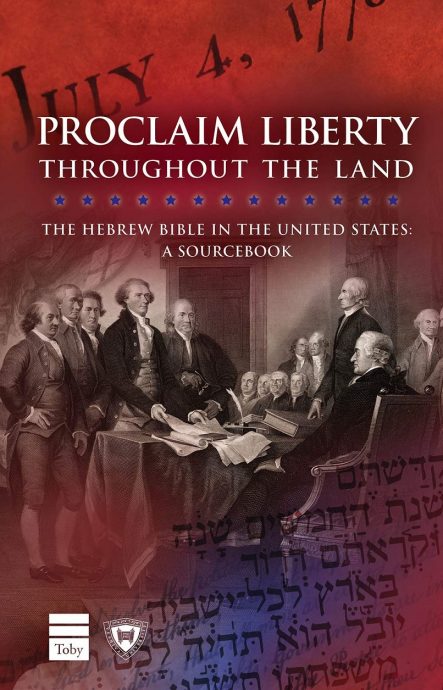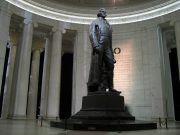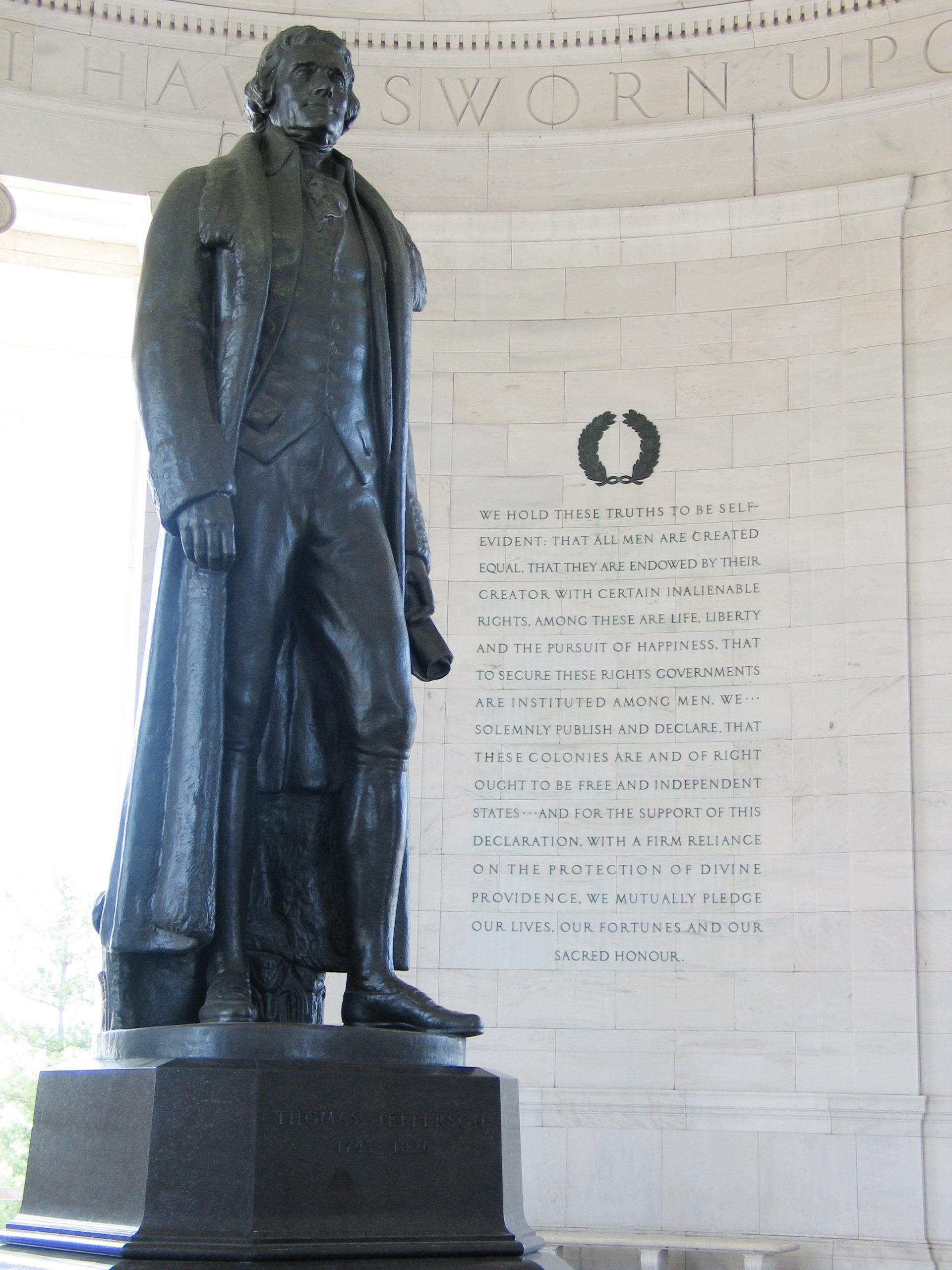The Israelites and the Americans
Nothing better illustrates how deeply rooted in the Hebrew Bible the American Republic is than the Great Seal of the United States, familiar to anyone who has ever seen a U.S. passport or any other official document of the federal government.
A bald-headed eagle, native and peculiar to North America (and thereby symbolic of it), bears an olive branch in one talon and a clutch of arrows in the other. Jointly they symbolize America’s disposition to extend peace to all who are willing to reciprocate, combined with its preparedness to deploy arms against whoever declines to do so. Protecting the eagle’s breast (and thus symbolically protecting the continent for which it stands) is a shield with a band of blue above 13 vertical red and white stripes, representing the original 13 states. The blue band represents the U.S. Congress, which unifies and renders the states a working republic. In the eagle’s beak is a ribbon bearing in Latin the slogan, “From Many, One.”
So far, nothing seems especially Hebraic about the iconography of this emblem. It is only in what is depicted above the eagle’s head that the Great Seal bears unmistakable witness to its Hebraic source of inspiration. Here, within a cloud—all mention of which in the Hebrew Bible invariably betokens the Divine Presence—is a constellation of 13 stars, which in the Seal’s current version (but not in the several versions proposed before 1781) are arrayed in the form of a Star of David.
Thus, what the seal draws upon, with the U.S. states standing in place of the Israelites, is what the Hebrew Bible says God instructed Moses to relay, in His name, to the Israelites assembled at the foot of Mount Sinai. This was immediately before they entered into that covenant with Him rendering them His specially chosen people in return for their accepting and obeying His commandments. As it says in Exodus 19:4-5:
Ye have seen what I did unto the Egyptians, and how I bore you on eagles’ wings, and brought you to myself.
Now therefore, if you will obey my voice and keep my covenant, you shall be my own possession among all peoples.
The Hebraic connotations of the actual seal go unmentioned in the new anthology edited by Meir Y. Soloveichik, Matthew Holbreich, Jonathan Silver, and Stuart W. Halpern. Instead, Proclaim Liberty Throughout the Land: The Hebrew Bible in the United States, a Sourcebook begins by recounting the equally Hebraic designs for the seal that Thomas Jefferson and Benjamin Franklin suggested in 1776. These were ultimately rejected in favor of the one put forward in 1781 by Charles Thomson, Secretary of Congress, whose name appears as a witness on the first published versions of the Declaration of Independence.
The Jefferson and Franklin suggestions involved scenes from Exodus that were intended to represent the American people as God’s chosen, like the Israelites, recently freed from oppressive tyrannical rule. The volume’s chief editor, Rabbi Soloveichik of New York City’s Yeshiva University, explains why it opens with the versions proposed by these two notorious Deists. He writes:
That these scenes from the book of Exodus loomed so large even in the minds of the men who were the most secular of the American founders is the ultimate indication that the imagery of the Hebrew Bible so dramatically impacted the thinking and language of American statesmen.
While the imagery that Jefferson and Franklin recommended for the seal might indeed show how dramatic the impact of the Hebrew Bible was on their public language, it unfortunately does nothing to show it had anything remotely approaching as dramatic an impact on their thinking. However frequently the Founding Fathers may have deployed Hebraic tropes and images in their speeches and writing, it remains deeply unclear how truly influential the Hebrew Bible was on their ideas for a new government separate from the British crown. References to God, let alone to any other Biblical imagery or tropes, are conspicuously absent from The Federalist Papers, as they also are from the U.S. Constitution. Still more strikingly, it is only Nature’s God, not that of the Bible, of whom the Declaration of Independence speaks.
Thus, no matter how frequently Biblical imagery and themes might have been deployed after the initial period of Puritan settlement and the so-called First Great Awakening of religiosity in the early decades of the 18th century, it is by no means clear, save in the case of sermons by clerics sympathetic to the Patriot cause, that the Hebrew Bible had much influence on salient figures or was the immediate source of the values and ideals any might have espoused in their rhetoric.
This matters because, as Rabbi Soloveichik explains in his Preface, Proclaim Liberty Throughout the Land was compiled with a view to “illustrating how the Bible inspired some of the most important documents in the history of the United States.” Sadly, it falls short of this aim.
Limited Government, Godly Government
The editors set forth four main ways in which they consider the Hebrew Bible to have influenced America’s political life and culture. It is said to have been a source of: 1) collective identity and self-identification; 2) political and cultural vocabulary; 3) rhetorical authority; and 4) powerful and eloquent language drawn from the King James Bible.
They have, ironically, left out a major way in which the Hebrew Bible can also be considered to have influenced American political life, albeit only indirectly: by its having been the ultimate source of inspiration for the mixed Constitution ratified in 1787. The Founding Charter provides for limited-term Presidents, a Senate, and an elected House of Representatives. These institutions jointly serve to check and balance each other, alongside an independent judiciary overseeing strict compliance by all government officials with the rule of law, severely circumscribing their powers.
Variants of all of these institutions are also mandated for the polity that the Hebrew Bible describes the Israelites as having been under divine mandate to establish in the Promised Land upon its conquest and settlement. It was certainly out of such a divine provenance that variants of this form of constitution came to be adopted by all of the Puritan colonies of New England prior to Independence. The demonstrated effectiveness, there, of this variety of political arrangement seems to have been the immediate inspiration for the Founding Fathers’ eventually opting for such a form of Constitution for the Republic itself.
The anthology contains a marvelously detailed account of the constitution that the Hebrew Bible reports was ordained for the Israelites, as well of its merits. The account was contained in a sermon delivered in Concord, New Hampshire in 1788 by Samuel Langdon, a former president of Harvard, entitled, “The Republic of the Israelites, an Example to the America States.” So far so good, but the editors do not explain how or why that Biblical prototype is also likely to have been an indirect source of inspiration for the Constitution itself by way of the models of it that the Puritans instituted in New England. Instead, they merely introduce Langdon’s sermon as “the most explicit example” of how, “throughout the Revolution, Americans continued to see themselves in a biblical mold.”
Sermons from Langdon to King
Thus, the major missing ingredients here are the Hebraic provenance of America’s actual Great Seal, and the equally Hebraic provenance of the U.S. Constitution by way of the Biblically inspired Puritan prototypes of New England. That said, Proclaim Liberty Throughout the Land more than makes up for these omissions by the array of well-chosen materials that it does contain, along with, in most cases, the Biblical verses on which the texts drew. The anthology provides the latter in both their original Hebrew as well as English translations taken from the King James edition.
The textual selections range from those of the Puritan settlement, such as the Mayflower Compact of 1620, through those of the Revolutionary period such as the aforementioned sermon of Langdon’s, to those from the ensuing decades of the Republic, up to and including the Civil War years and the periods during which Americans campaigned to abolish slavery.
There are some surprises here. One is the inclusion of a defense of the Biblical exoneration of slavery, albeit not in its inhumane American form, made in 1861 by Rabbi Morris Jacob Raphall of New York who, a year earlier, had become the first Jewish clergyman to be invited to deliver an opening prayer in Congress. Rabbi Raphall, who was pro-Union, claimed only to be explicating the word of God—even while being “no friend to slavery in the abstract, and still less friendly to the practical working of slavery.”
The anthology ends with an extract from the last speech given by the Reverend Dr. Martin Luther King, Jr., delivered in Memphis on April 3, 1968, which was the day before his assassination. In it, the African American civil rights leader likened himself to Moses at the end of his days, when he was given a glimpse of the Promised Land that he would not be allowed to enter. In the face of death threats, which he acknowledged in the speech, he likened himself to Moses, declaiming, in his unmistakable and unforgettably sonorous tones: “Well, I don’t know what will happen now. We’ve got some difficult days ahead. But it really doesn’t matter with me now, because I’ve been to the mountaintop . . . And I’ve looked over. And I’ve seen the Promised Land.”



